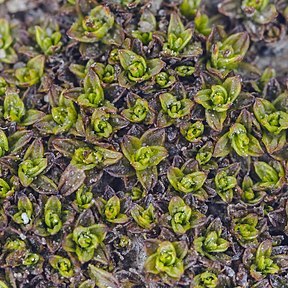Plants small, gregarious or in loose patches, dark green to blackish dry, green to light green wet; terricolous or saxicolous. Stems short, 2-5 mm high, sparingly branched; in section with central strand, inner cortical cells lax, outer cortical cells in 1-3 rows, smaller, reddish. Leaves incurled, spirally twisted or contorted dry, wide-spreading wet; shape extremely variable, oval to oblong on short-leaved plants or oblong to lingulate on long-leaved plants; apex acute to obtuse; margins narrowly revolute, entire. Costa percurrent, strongly convex ventrally in upper leaf; ventral superficial cells quadrate, papillose, dorsal superficial cells elongate, strongly incrassate, smooth; in section oval, guide cells 4-6, ventral cells in 1-2 layers, surface cells enlarged, frequently vertically elongated, papillose, dorsal stereid band 4-6 cells thick, dorsal surface cells substereids. Upper laminal cells quadrate to hexagonal, with 4-6 C-shaped papillae over lumen; cells of revolute margins smooth or nearly so, rarely all laminal cells only weakly papillose; basal cells rectangular, lax, smooth. Autoicous. Perichaetia terminal, leaves undifferentiated. Seta 6-15 mm long, yellow to reddish; capsule ovoid to cylindrical, 1.0-2.5 mm long, reddish brown; peristome teeth divided into 2 papillose filaments above short basal membrane, 0.3-0.5 mm high, yellowish, frequently irregular, broken; operculum conical to obliquely rostrate, 1 mm long; spores roundish, 17-25 µm, finely punctate.
More
Leaves ovate to lingulate, apex broadly acute to rounded, apiculate or mucronate, margins revolute or occasionally plane, often bordered proximally with rectangular cells usually hidden in the revolute margins; costa percurrent or ending in apiculus or short mucro, with an adaxial pad of swollen cells similar to those of the lamina, distally broad, (4-)6(-8) cells across adaxial surface; distal laminal cells subquadrate, 9-13(-18) µm wide, µm, 1:1; strongly papillose. Sexual condition autoicous. Sporophytes exerted. Seta 0.6-1.2 cm. Capsule stegocarpic, not systylius, cylindric to ellipsoidal, erect and nearly straight, urn 0.9-1.5 mm; peristome commonly 210-390 µm, teeth of 32 filaments, weakly twisted, occasionally rudimentary, basal membrane 40-50 µm; operculum 0.5-0.7 mm. Spores 15-18 µm, broadly ellipsoidal, nearly smooth.
Plants gregarious or in loose patches. Stems 2-5 mm long, central strand present. Leaves incurled, spirally twisted or contorted when dry, oval to oblong or lingulate; apex acute to obtuse; margins narrowly revolute; costa percurrent, convex ventrally, ventral stereid band absent. Upper laminal cells quadrate to hexagonal, with 4-6 C-shaped papillae; basal cells lax, smooth. Capsule cylindrical, peristome teeth divided into filaments. Recognised by the enlarged ventral cells of the upper costa.

